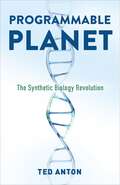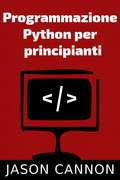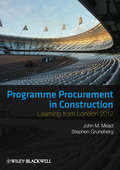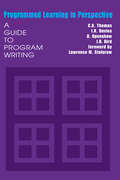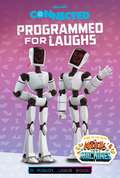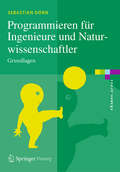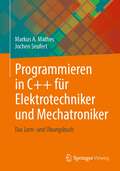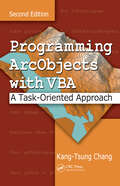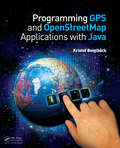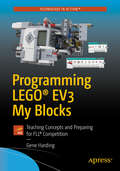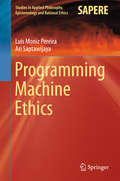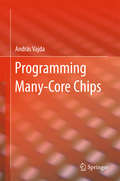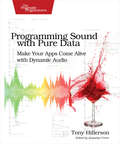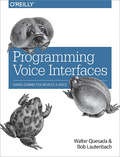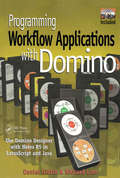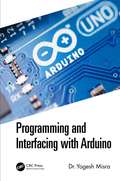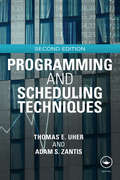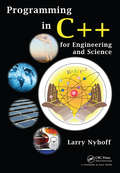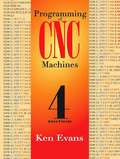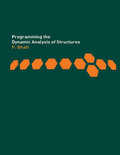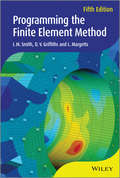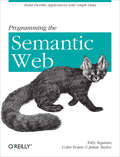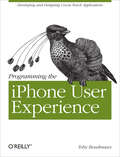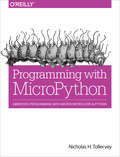- Table View
- List View
Programmable Planet: The Synthetic Biology Revolution
by Ted AntonA new science is reengineering the fabric of life. Synthetic biology offers bold new ways of manufacturing medicines, clothing, foods, fragrances, and fuels, often using microbe fermentation, much like brewing beer. The technology can help confront climate change, break down industrial pollutants, and fight novel viruses. Today, researchers are manipulating life forms and automating evolution to create vegetarian “meat,” renewable construction materials, and cancer treatments. In the process, they are changing our concept of what life science can achieve. Is this a new industrial and information revolution—or dangerous tinkering that could unleash unintended consequences?Programmable Planet is a grand tour through the world of synthetic biology, telling the stories of the colorful visionaries whose ideas are shaping discoveries. Ted Anton explores the field from its beginning in fighting malaria in Africa to the COVID vaccines and beyond. Covering medical and agricultural triumphs and blunders, he examines successes in energy production, plant gene editing, and chemical manufacturing, as well as the most controversial attempts at human gene enhancement. This book reports from the front lines of research, showing policy makers’ struggle to stay abreast of the technologies they aim to regulate. Even-handed, lively, and informative, Programmable Planet gives a glimpse of the promise and problems of a new biology-based industry.
Programmazione Python Per Principianti
by Eugenia Franzoni Jason CannonSe volete imparare a programmare in Python ma non sapete da dove iniziare, continuate a leggere.Sapere dove iniziare quando si impara qualcosa di nuovo può essere un problema, soprattutto se l'argomento sembra così vasto. Ci possono essere così tante informazioni a disposizione che non si riesce nemmeno a decidere da dove iniziare, o peggio, si comincia ad imparare e si scoprono velocemente così tanti concetti, esempi di programmazione e dettagli che non vengono spiegati. Questo tipo di esperienza è frustrante e lascia con più domande che risposte.Programmazione Python per principianti non dà per scontato niente su quello che già conoscete della programmazione o del linguaggio Python. Non serve sapere niente per trarre beneficio da questo libro. Verrete guidati passo dopo passo usando un approccio logico e sistematico. A mano a mano che incontrerete nuovi concetti, codice e termini, questi verranno spiegati in linguaggio chiaro, rendendo semplice comprenderli per chiunque.Ecco cosa imparerete leggendo questo libro:Quando usare Python 2 e quando Python 3.Come installare Python su Windows, Mac e Linux, con gli screenshots.Come preparare il computer per programmare in Python.I vari modi di eseguire programmi Python su Windows, Mac e Linux.I migliori editor di testo e ambienti di sviluppo integrati per scrivere codice.Come lavorare con vari tipi di dato: stringhe, liste, tuple, dizionari, booleani ed altri.Cosa sono le variabili e quando usarle.Come fare operazioni matematiche in Python.Come prendere l'input utente.Come controllare il flusso dei programmi.L'importanza degli spazi in Python.Come organizzare i programmi, cosa va dove.Cosa sono i moduli, quando usarli e come crearne di vostri.Come definire e usare le funzioni.Importare le funzioni Python che si usano di frequente.Come leggere e s
Programme Procurement in Construction: Learning from London 2012
by Stephen Gruneberg John Mead"This book ... adds to the impressive 'legacy' of learning which is still emerging from the successful delivery of the London 2012 construction programme. The authors combine the reforming zeal of a champion for change, who was there every step of the way, with academic rigour, and the result is delivered with impressive passion and commitment to the topic … All spenders and suppliers need to read this, to understand how conventional understandings of procurement fall so dramatically short when applied to high value-high risk acquisitions, which invariably is what large construction projects represent."—Don Ward, Chief Executive, Constructing Excellence, UK Successful construction is often attributed to one or more aspects of the delivery process from good planning, design and clever engineering to efficient project management and quality construction. Before any of these disciplines can begin, they all require some form of procurement to select the team or supply chain to meet a client’s or a project’s specific requirements. The concept of PSE - Purchase and Supplier Engineering - originated in the procurement of the construction and infrastructure required to stage the 30th Olympiad in London during 2012. At the time of writing PSE has successfully delivered almost £25bn of public procurement meeting client and project requirements and without legal challenge. The construction of the venues and infrastructure needed to stage London 2012 was such a resounding success that it boosted not only the reputation of the UK construction industry but also the confidence of the UK population in the country’s ability to organise, build and run a major international event. Its success has been lauded as something from which clients and industry could learn. The ODA has established a comprehensive and informative body of evidence as part of a Learning Legacy. While the ODA is well aware of the many elements of the procurement and supply chain management, the complete end to end concept of how the Olympic supply chain procurements were managed has until now not been captured. For example, how does one buy the stage for an Olympic Games? How does one manage the details of thousands of contracts and the many firms of contractors, subcontractors and material suppliers and ensure that no one organisation adversely affects any other to the detriment of the programme? How are a client’s requirements beyond those of the capital asset realised as part of the investment? How does one measure programme exposure, or manage performance? How does one measure capacity and the ability of firms to cope with the work and manage the risks involved? Programme Procurement in Construction: Learning from London 2012 covers the planning and preparation of a programme’s procurement processes from understanding and developing the client’s requirements, to monitoring performance based on the benchmarks contractors set out in their own tender submissions. The emphasis is on a close attention to detail to avoid surprises, while keeping a focus on the total programme. Purchase and Supplier Engineering provides an overview of managing the interest of firms in participating and the resulting capacity and workloads of all suppliers, including the main contractors and the critical subcontractors and material suppliers. Offering techniques, tips and lessons learnt from the implementation of PSE on London 2012 and Crossrail, this book is aimed at public and private sector clients, developers, senior management and those businesses and professionals involved in undertaking the procurement, supply chain management and delivery of multiple construction projects or complex major construction programmes.
Programmed Learning in Perspective: A Guide to Program Writing
by I.K. DaviesThe method of programming outlined in this book represents a major contribution to the growing body of literature in programmed learning. It is the first book in the field to present a carefully designed, complete and integrated system for analyzing, organizing and structuring learning materials in programmed form.Application of the system is illustrated through the step-by-step construction of two short programs. Starting with the analysis of the syllabus and course content, the authors take the reader through each phase of the programming process gathering and organizing the content material, construction of the program matrix and flow diagram and finally, the writing of frames.Every teacher and trainer can benefit from the application of this method to lesson plan preparation and to classroom teaching techniques. Such a method is essential, for all those who are writing programmed materials. In a new computer age classroom environment, programmed learning can be especially beneficial.C. A. Thomas, I. K. Davies, D. Openshaw, and J. B. Bird are instructors or directors at the British Royal Air Force School of Education. They are pioneers in the application of programmed learning in Britain and are highly regarded as forward looking and creative educational research workers. Their accomplishments include, in addition to this ingenious book, the design and development of the Empirical Tutor, one of Britain's major teaching machines, and the publication of a number of technical papers in the field of programmed learning.Lawrence M. Stolurow is professor emeritus of psychological & quantitative foundations at the University of Iowa.
Programmed for Laughs: A Robot Joke Book (Connected, based on the movie The Mitchells vs. the Machines)
by Matt ChapmanIn this joke book companion to the hilarious and offbeat motion picture The Mitchells vs. the Machines from Sony Pictures Animation, robots Eric and Deborahbot 5000 team up to write robot jokes with side-splitting results!When the delightfully dysfunctional Mitchell family&’s road trip is interrupted by a worldwide tech uprising, they join forces with two hilarious malfunctioning robots to save humanity before it&’s too late. In this book, robots Eric and Deborahbot 5000 form a team of their own as they crack jokes about the Mitchell family&’s accidental heroism and what the robot apocalypse is really like. This laugh-out-loud joke book will leave readers of all ages snorting, spitting out their drinks, and otherwise malfunctioning!
Programmieren für Ingenieure und Naturwissenschaftler: Grundlagen (eXamen.press)
by Sebastian DörnZiel des Buches ist es, Studierenden der Ingenieur- oder Naturwissenschaften die Programmierung als Schlüsselqualifikation mit zahlreichen Anwendungsmöglichkeiten vorzustellen. Die Umsetzung von Programmierkonzepten und algorithmischen Verfahren erfolgt in diesem Buch in Java. Im ersten Teil gibt der Autor eine Einführung in die Grundkonzepte von Java, im zweiten Teil werden algorithmische Verfahren aus dem Bereich der Numerik, sowie allgemeine Methoden zum Entwurf von Algorithmen vorgestellt. Im dritten Teil werden Grundlagen der objektorientierten Programmierung dargestellt sowie ein Überblick über die Erstellung von graphischen Benutzeroberflächen gegeben. Ein Kapitel zu diversen Anwendungen aus dem Bereich der Ingenieur- und Naturwissenschaften sowie Aufgaben und Lösungen in jedem Kapitel runden das Buch ab.
Programmieren in C++ für Elektrotechniker und Mechatroniker: Das Lern- und Übungsbuch
by Prof. Dr. Mathes Prof. Dr. SeufertDas Buch Programmieren in C++ für Elektrotechniker und Mechatroniker bietet einen Einstieg in die moderne Softwareentwicklung für Studierende der Ingenieurwissenschaften. Dabei wird ein durchgängiger Ansatz verfolgt, der, beginnend mit den Grundlagen der Programmierung, bis hin zu weiterführenden Themen, wie Hardware-nahe Programmierung, zahlreiche Themengebiete betrachtet und Studierende nicht nur für die Prüfung, sondern auch für den Arbeitsalltag vorbereitet. Da man Programmieren nur durch Üben erlernen kann, liefert das Buch einen umfangreichen Aufgabenkatalog.
Programming ArcObjects with VBA: A Task-Oriented Approach, Second Edition
by Kang-Tsung ChangIf you're ready to take your knowledge of ArcGIS to the next level, then you need to learn how to work with ArcObjects. But with thousands of objects, properties, and methods, how can you ever hope to sort through the ArcObjects model diagrams?The first edition of Chang's Programming ArcObjects with VBA: A Task-Oriented Approach gave us the answer. The author's task-oriented approach shows you how to sort through the massive ArcObjects collection by examining only the objects, properties, and methods you need to perform specific tasks.What's new in the second edition?This edition adds macros and explanations for the new Geoprocessing object introduced in ArcGIS 9.x. Instead of treating this new feature in separate chapters, the author incorporates Geoprocessing code into the existing chapters. The code appears conveniently in boxes that allow you to easily compare sample macros.Get Started with Ready-to-Use CodeThe downloadable resources contain 95 complete ArcObjects macros and 33 Geoprocessing macros, along with datasets to execute the code. Each program begins with a short usage description and a list of key properties and methods, followed by the listing and explanation of the code itself.Regardless of your programming experience, Programming ArcObjects with VBA: A Task-Oriented Approach, Second Edition gives you the key to unlock the power and versatility of using ArcObjects to help you manage GIS activities.
Programming GPS and OpenStreetMap Applications with Java: The RealObject Application Framework
by Kristof BeiglböckWritten by an expert in the development of GPS systems with digital maps and navigation, Programming GPS and OpenStreetMap Applications with Java: The RealObject Application Framework provides a concrete paradigm for object-oriented modeling and programming. It presents a thorough introduction to the use of available global positioning data for the
Programming LEGO® EV3 My Blocks: Teaching Concepts And Preparing For Fll® Competition
by Gene HardingProgram Lego® My Blocks to accurately perform navigation functions on competition mats, such as moving forward and backward quickly and precisely, turning, following walls, and following lines. This book features extensive illustrations help to bring each step and concept to life so that you can easily follow along. You'll start by moving your creations forward and backward accurate distances while maintaining directional accuracy. You'll then build My Blocks to turn left and right at precise angles. After that you’re creations will be ready to find, follow, and otherwise use lines on the mat to improve navigation accuracy. Finally, you'll delve into using game board border walls to navigate and advanced topics, such as handoffs at speed and accelerating/decelerating to enable higher speed while maintaining navigation accuracy.This book addresses EV3 programming in the specific context of FLL® competition. With Programming Lego® EV3 My Blocks, you will be game-ready to manage the season, prepare for competition, and compete!What You'll Learn Construct and use My Blocks to improve robot performance in the FLL® Robot Game Develop basic programming skills, including feedback, troubleshooting techniques, and unit conversion Comment programs appropriately to note errors and consistencyWho This Book Is For The book is targeted at the many FLL® coaches, mentors, and students who need help with programming the EV3, as well as the students they coach. A secondary audience is teachers who want to use the EV3 to teach programming concepts.
Programming Machine Ethics
by Luís Moniz Pereira Ari SaptawijayaThis book addresses the fundamentals of machineethics. It discusses abilities required for ethical machine reasoning and theprogramming features that enable them. It connects ethics, psychologicalethical processes, and machine implemented procedures. From a technical pointof view, the book uses logic programming and evolutionary game theory to modeland link the individual and collective moral realms. It also reports on theresults of experiments performed using several model implementations. Opening specific and promising inroads into the terra incognita of machine ethics, theauthors define here new tools and describe a variety of program-tested moralapplications and implemented systems. In addition, they provide alternativereadings paths, allowing readers to best focus on their specific interests andto explore the concepts at different levels of detail. Mainly written for researchers in cognitivescience, artificial intelligence, robotics, philosophy of technology andengineering of ethics, the book willalso be of general interest to otheracademics, undergraduates in search of research topics, science journalists aswell as science and society forums, legislators and military organizationsconcerned with machine ethics.
Programming Many-Core Chips
by András VajdaThis book presents new concepts, techniques and promising programming models for designing software for chips with "many" (hundreds to thousands) processor cores. Given the scale of parallelism inherent to these chips, software designers face new challenges in terms of operating systems, middleware and applications. This will serve as an invaluable, single-source reference to the state-of-the-art in programming many-core chips. Coverage includes many-core architectures, operating systems, middleware, and programming models.
Programming Sound with Pure Data: Make Your Apps Come Alive with Dynamic Audio
by Tony HillersonFor intermediate programmers, beginning sound designers.Sound gives your native, web, or mobile apps that extra dimension, and it's essential for games. Rather than using canned samples from a sample library, learn how to build sounds from the ground up and produce them for web projects using the Pure Data programming language. Even better, you'll be able to integrate dynamic sound environments into your native apps or games--sound that reacts to the app, instead of sounding the same every time. Start your journey as a sound designer, and get the power to craft the sound you put into your digital experiences. Add sound effects or music to your web, Android, and iOS apps and games--sound that can react to changing environments or user input dynamically (at least in the native apps). You can do all this with Pure Data, a visual programming language for digital sound processing.Programming Sound with Pure Data introduces and explores Pure Data, building understanding of sound design concepts along the way. You'll start by learning Pure Data fundamentals and applying them, creating realistic sound effects. Then you'll see how to analyze sound and re-create what you hear in a recorded sample. You'll apply multiple synthesis methods to sound design problems. You'll finish with two chapters of real-world projects, one for the web, and one for an iOS and Android app. You'll design the sound, build the app, and integrate effects using the libpd library.Whether you've had some experience with sound synthesis, or are new to sound design, this book is for you. These techniques are perfect for independent developers, small shops specializing in apps or games, and developers interested in exploring musical apps.
Programming Voice Interfaces
by Walter Quesada Bob LautenbachGet a step-by-step guide for developing voice interfaces for applications and devices connected to the Internet of Things. By allowing consumers to use natural human interactions, you can avoid awkward methods of input and interactivity to provide them with elevated user experiences. This practical book is ideal for software engineers who build applications for the Web, smartphones, as well as embedded systems that dominate the IoT space.Integrate voice interfaces with internet connected devices and sensorsLearn how to integrate with existing voice interfacesUnderstand when to use a voice over other Natural User Interface technologiesBuild a prototype with tools such as Raspberry Pi, solderless breadboards, jumper cables, sensors, Arduino, Visual Studio, and other toolsUse cloud services such as Azure and AWS to integrate voice with your existing or new web service end-points
Programming Workflow Applications with Domino
by Daniel Giblin Richard LamHarness the power of groupware to reshape business processes and customer interactions. This book will permit you to implement Web-based workflow applications using the industry-standard groupware environment, Domino R5. This work demonstrates how Lotus Notes/Domino can be used to deliver groupware applications through intranets, extranets and the Internet. It contains a reusable and customisable workflow application, with annotated source code created in the latest version of Notes.
Programming and Interfacing with Arduino
by Yogesh MisraProgramming and Interfacing with Arduino provides an in-depth understanding of the Arduino UNO board. It covers programming concepts, working and interfacing of sensors, input/output devices, communication modules, and actuators with Arduino UNO board. This book contains a large number of programming examples along with the description and interfacing details of hardware with Arduino UNO board. It discusses important topics, including SPI communication protocol, I2C communication protocol, light-emitting diode, potentiometer, analog-to-digital converter, pulse width modulation, temperature sensor LM35, humidity and temperature sensor DHT11, motor driver L293D, LED interfacing and programming, and push-button interfacing and programming. Aimed at senior undergraduate students and professionals in areas such as electrical engineering, electronics, and communication engineering, this text: Discusses construction and working of sensors, including ultrasonic sensor, temperature sensor, and optical sensor. Covers construction, working, programming, and interfacing of IO devices. Discusses programming, interfacing construction, and working of relay with the Arduino board for controlling high-voltage devices. Covers interfacing diagram of devices with the Arduino board. Provides videos demonstrating the implementation of programs on the Arduino board.
Programming and Scheduling Techniques
by Thomas Uher Adam S. ZantisPlanning is an important management function and its effective execution is crucial to ensure the success of any project. This second edition of Thomas Uher’s and Adam Zantis' textbook maintains its focus on operational rather than strategic aspects of programming and scheduling of projects, providing the reader with the practical planning skills needed to be successful. Unlike most other textbooks that largely focus on the critical path method, Programming and Scheduling Techniques includes a comprehensive review of a range of practices used around the world. Topics covered in this thoroughly revised edition include: deterministic scheduling techniques including the bar chart, the critical path method, the critical chain method, the multiple activity chart and the line of balance a comparison of the critical path and critical chain scheduling techniques options for computer-based scheduling stochastic scheduling techniques including the critical path method based on Monte Carlo simulation and the Program Evaluation and Review Technique (PERT) risk in scheduling work study. By covering a broad range of scheduling techniques this book is suitable for those planning projects in any industry, particularly in interdisciplinary or international contexts. Learning activities, step-by-step guides, and a downloadable answers booklet make sure no reader is left behind. Written for students studying undergraduate and postgraduate architecture, building, construction/project management, quantity surveying, property development and civil engineering programs.
Programming in C++ for Engineering and Science
by Larry NyhoffDeveloped from the author's many years of teaching computing courses, Programming in C++ for Engineering and Science guides students in designing programs to solve real problems encountered in engineering and scientific applications. These problems include radioactive decay, pollution indexes, digital circuits, differential equations, Internet addr
Programming of CNC Machines
by Ken EvansWritten in a simple, easy-to-understand language by a skilled programmer with many years of experience teaching CNC machining to industry and in the classroom, this new edition offers a new chapter on feature-based Machining using Siemens, plus a new chapter featuring Fanuc NC guide I programming. It provides full descriptions of many operation and programming functions and illustrates their practical applications through examples. It provides in-depth information on how to program turning and milling machines, which is applicable to almost all control systems. It keeps all theoretical explanations to a minimum throughout so that they do not distort an understanding of the programming. And because of the wide range of information available about the selection of tools, cutting speeds, and the technology of machining, it is sure to benefit engineers, programmers, supervisors, and machine operators who need ready access to information that will solve CNC operation and programming problems.
Programming the Dynamic Analysis of Structures
by Prab BhattThis book presents a series of integrated computer programs in Fortran-90 for the dynamic analysis of structures, using the finite element method. Two dimensional continuum structures such as walls are covered along with skeletal structures such as rigid jointed frames and plane grids. Response to general dynamic loading of single degree freedom sy
Programming the Finite Element Method
by D. V. Griffiths L. Margetts I. M. SmithMany students, engineers, scientists and researchers have benefited from the practical, programming-oriented style of the previous editions of Programming the Finite Element Method, learning how to develop computer programs to solve specific engineering problems using the finite element method.This new fifth edition offers timely revisions that include programs and subroutine libraries fully updated to Fortran 2003, which are freely available online, and provides updated material on advances in parallel computing, thermal stress analysis, plasticity return algorithms, convection boundary conditions, and interfaces to third party tools such as ParaView, METIS and ARPACK. As in the previous editions, a wide variety of problem solving capabilities are presented including structural analysis, elasticity and plasticity, construction processes in geomechanics, uncoupled and coupled steady and transient fluid flow and linear and nonlinear solid dynamics.Key features:* Updated to take into account advances in parallel computing as well as new material on thermal stress analysis* Programs use an updated version of Fortran 2003* Includes exercises for students* Accompanied by website hosting softwareProgramming the Finite Element Method, Fifth Edition is an ideal textbook for undergraduate and postgraduate students in civil and mechanical engineering, applied mathematics and numerical analysis, and is also a comprehensive reference for researchers and practitioners.Further information and source codes described in this text can be accessed at the following web sites:* www.inside.mines.edu/~vgriffit /PFEM5 for the serial programs from Chapters 4-11* www.parafem.org.uk for the parallel programs from Chapter 12
Programming the Finite Element Method
by L. Margetts I. M. Smith D. V. GriffithsMany students, engineers, scientists and researchers have benefited from the practical, programming-oriented style of the previous editions of Programming the Finite Element Method, learning how to develop computer programs to solve specific engineering problems using the finite element method. This new fifth edition offers timely revisions that include programs and subroutine libraries fully updated to Fortran 2003, which are freely available online, and provides updated material on advances in parallel computing, thermal stress analysis, plasticity return algorithms, convection boundary conditions, and interfaces to third party tools such as ParaView, METIS and ARPACK. As in the previous editions, a wide variety of problem solving capabilities are presented including structural analysis, elasticity and plasticity, construction processes in geomechanics, uncoupled and coupled steady and transient fluid flow and linear and nonlinear solid dynamics. Key features: • Updated to take into account advances in parallel computing as well as new material on thermal stress analysis • Programs use an updated version of Fortran 2003 • Includes exercises for students • Accompanied by website hosting software Programming the Finite Element Method, Fifth Edition is an ideal textbook for undergraduate and postgraduate students in civil and mechanical engineering, applied mathematics and numerical analysis, and is also a comprehensive reference for researchers and practitioners. Further information and source codes described in this text can be accessed at the following web sites: • www.inside.mines.edu/~vgriffit /PFEM5 for the serial programs from Chapters 4-11 • www.parafem.org.uk for the parallel programs from Chapter 12
Programming the Semantic Web: Build Flexible Applications with Graph Data
by Toby Segaran Colin Evans Jamie TaylorWith this book, the promise of the Semantic Web -- in which machines can find, share, and combine data on the Web -- is not just a technical possibility, but a practical reality Programming the Semantic Web demonstrates several ways to implement semantic web applications, using current and emerging standards and technologies. You'll learn how to incorporate existing data sources into semantically aware applications and publish rich semantic data.Each chapter walks you through a single piece of semantic technology and explains how you can use it to solve real problems. Whether you're writing a simple mashup or maintaining a high-performance enterprise solution,Programming the Semantic Web provides a standard, flexible approach for integrating and future-proofing systems and data.This book will help you:Learn how the Semantic Web allows new and unexpected uses of data to emergeUnderstand how semantic technologies promote data portability with a simple, abstract model for knowledge representationBecome familiar with semantic standards, such as the Resource Description Framework (RDF) and the Web Ontology Language (OWL)Make use of semantic programming techniques to both enrich and simplify current web applications
Programming the iPhone User Experience: Developing and Designing Cocoa Touch Applications
by Toby BoudreauxApple's iPhone and iPod Touch not only feature the world's most powerful mobile operating system, they also usher in a new standard of human-computer interaction through gestural interfaces and multi-touch navigation. This book provides you with a hands-on, example-driven tour of UIKit, Apple's user interface toolkit, and includes common design patterns to help you create new iPhone and iPod Touch user experiences. Using Apple's Cocoa Touch framework, you'll learn how to build applications that respond in unique ways when users tap, slide, swipe, tilt, shake, or pinch the screen. Programming the iPhone User Experience is a perfect companion to Apple's Human Interface Guidelines, and provides the practical information you need to develop innovative applications for the iPhone and iPod Touch, whether you're a CTO, developer, or UI/UX designer.Understand the basics of the Cocoa Touch framework for building iPhone and iPod Touch applications Learn theory and best practices for using Cocoa Touch to develop applications with engaging and effective user interfaces Apply your knowledge of Objective-C to the iPhone/iPod Touch framework Customize standard UIKit views according to Apple's Human Interface Guidelines and usability principles Learn patterns for handling user experience concerns outside of the interface, such as network- and location-awareness
Programming with MicroPython: Embedded Programming with Microcontrollers and Python
by Nicholas H. TollerveyIt’s an exciting time to get involved with MicroPython, the re-implementation of Python 3 for microcontrollers and embedded systems. This practical guide delivers the knowledge you need to roll up your sleeves and create exceptional embedded projects with this lean and efficient programming language. If you’re familiar with Python as a programmer, educator, or maker, you’re ready to learn—and have fun along the way.Author Nicholas Tollervey takes you on a journey from first steps to advanced projects. You’ll explore the types of devices that run MicroPython, and examine how the language uses and interacts with hardware to process input, connect to the outside world, communicate wirelessly, make sounds and music, and drive robotics projects.Work with MicroPython on four typical devices: PyBoard, the micro:bit, Adafruit’s Circuit Playground Express, and ESP8266/ESP32 boardsExplore a framework that helps you generate, evaluate, and evolve embedded projects that solve real problemsDive into practical MicroPython examples: visual feedback, input and sensing, GPIO, networking, sound and music, and roboticsLearn how idiomatic MicroPython helps you express a lot with the minimum of resourcesTake the next step by getting involved with the Python community
